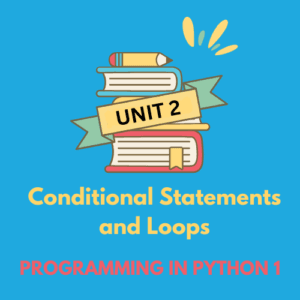
Click On the Download Button Below 
Introduction to Conditional Statements and Loops In Python :-
In Python, conditional statements and loops are fundamental concepts used for controlling the flow of a program.
Conditional Statements: These are used to execute specific blocks of code based on whether a condition is true or false. Python uses the
if,elif, andelsekeywords to handle decision-making in programs, allowing the program to take different actions depending on the input or state.Loops: Loops are used to repeat a block of code multiple times. Python supports two types of loops:
- The
forloop, which iterates over a sequence (like a list, string, or range). - The
whileloop, which repeats as long as a given condition is true.
- The
Together, conditional statements and loops enable Python programs to make decisions and perform repetitive tasks efficiently.
Objectives of Conditional Statements and Loops In Python :-
Conditional Statements:
- Enable the program to make decisions based on conditions.
- Execute different blocks of code depending on whether a condition is true or false.
- Improve program flexibility by allowing multiple pathways of execution.
- Facilitate error handling and validation through conditions.
Loops:
- Allow repetitive execution of code, reducing redundancy.
- Handle tasks that require iteration over sequences (e.g., lists, ranges).
- Enable continuous execution as long as a condition holds true.
- Enhance efficiency by automating repetitive operations, like processing large data sets.
List of References for Conditional Statements and Loops In Python :-
- Charles Dierbach, Introduction to Computer Science using Python, Wiley, 2013
- Paul Gries , Jennifer Campbell, Jason Montojo, Practical Programming: An Introduction to ComputerScience Using Python 3, Pragmatic Bookshelf, 2/E 201
Summary of Conditional Statements and Loops In Python :-
In Python, conditional statements and loops are essential tools for controlling the flow of execution in a program.
Conditional Statements (
if,elif,else): These allow the program to make decisions by evaluating conditions. Based on whether a condition is true or false, different blocks of code are executed. This enables the program to handle various scenarios and take different actions accordingly.Loops (
for,while): Loops are used to repeat a block of code multiple times. Theforloop iterates over a sequence, such as a list or range, while thewhileloop continues executing as long as a specified condition remains true. Loops are essential for tasks that require repeated actions, such as processing elements in a collection or performing operations until a condition is met.
Together, conditional statements and loops provide the ability to control program flow, making it possible to perform complex tasks and handle various situations effectively.
